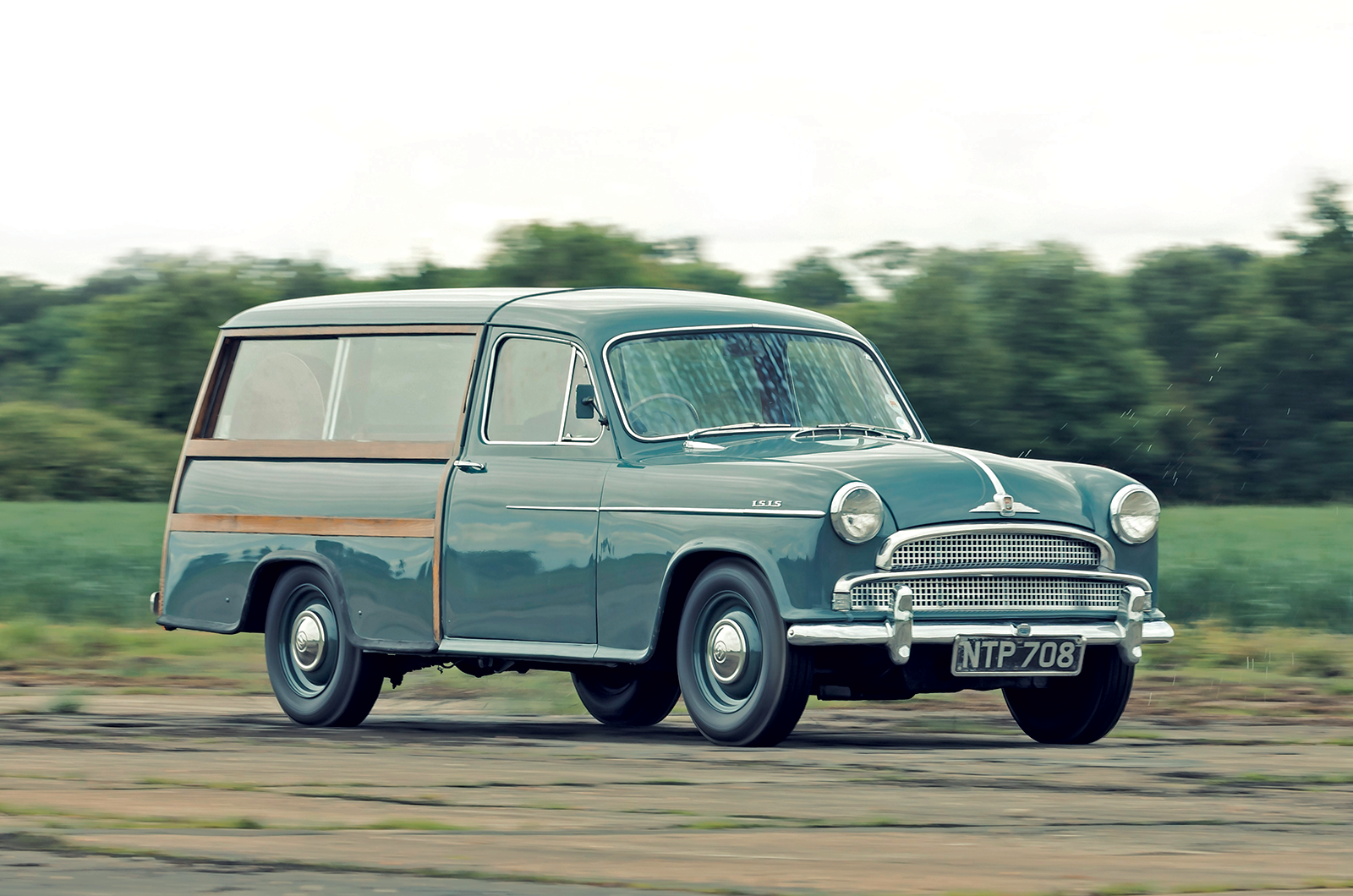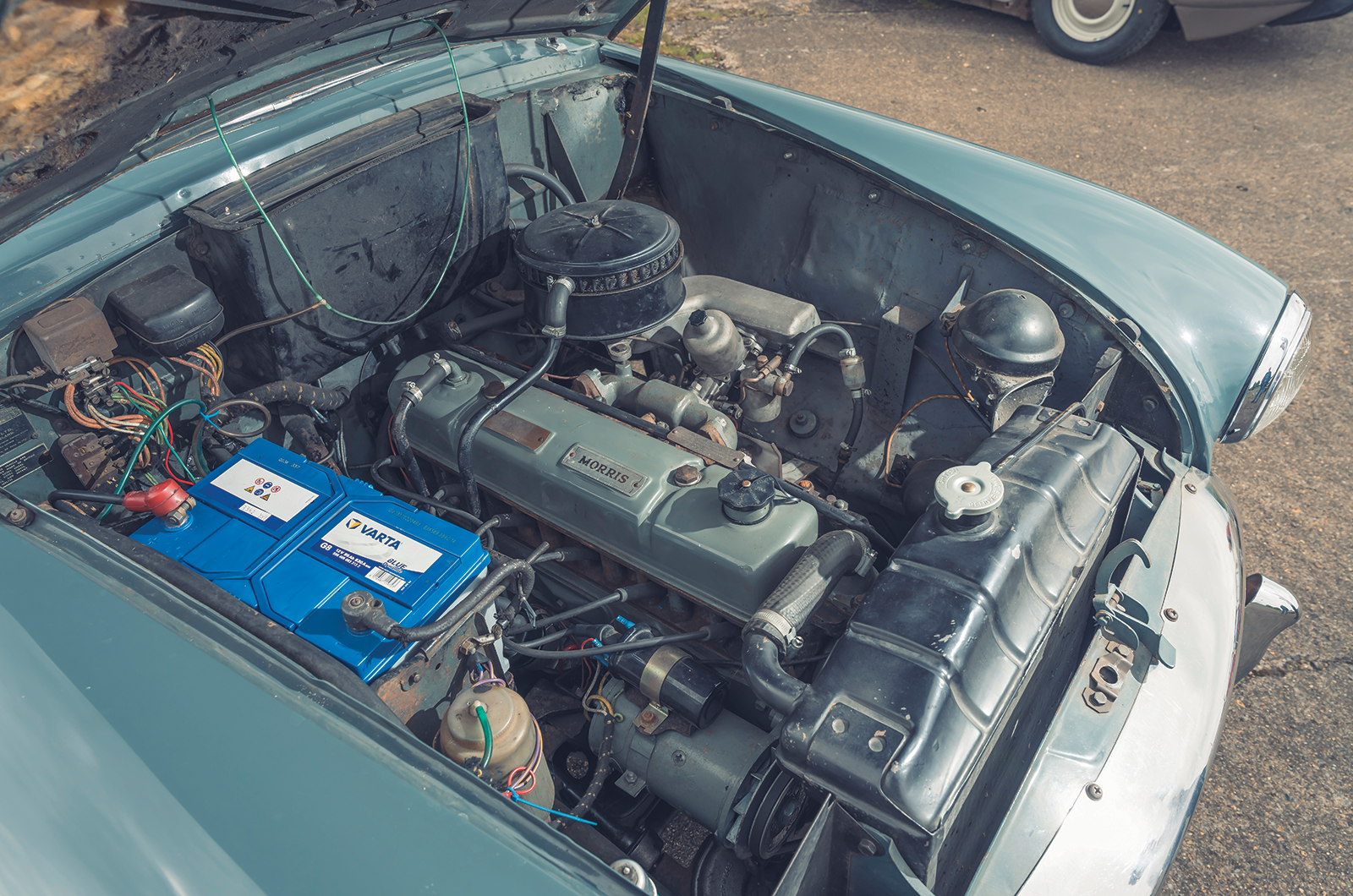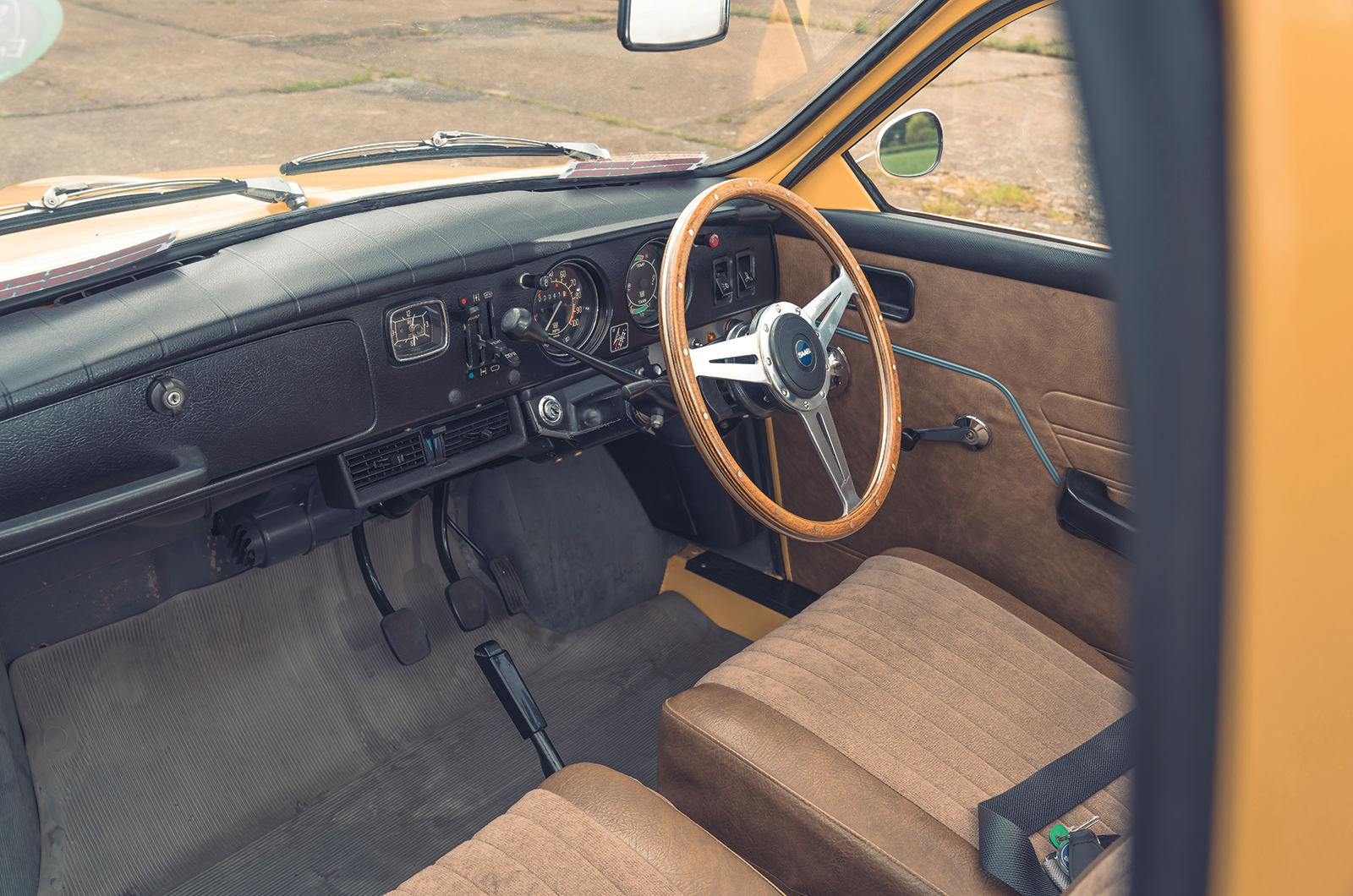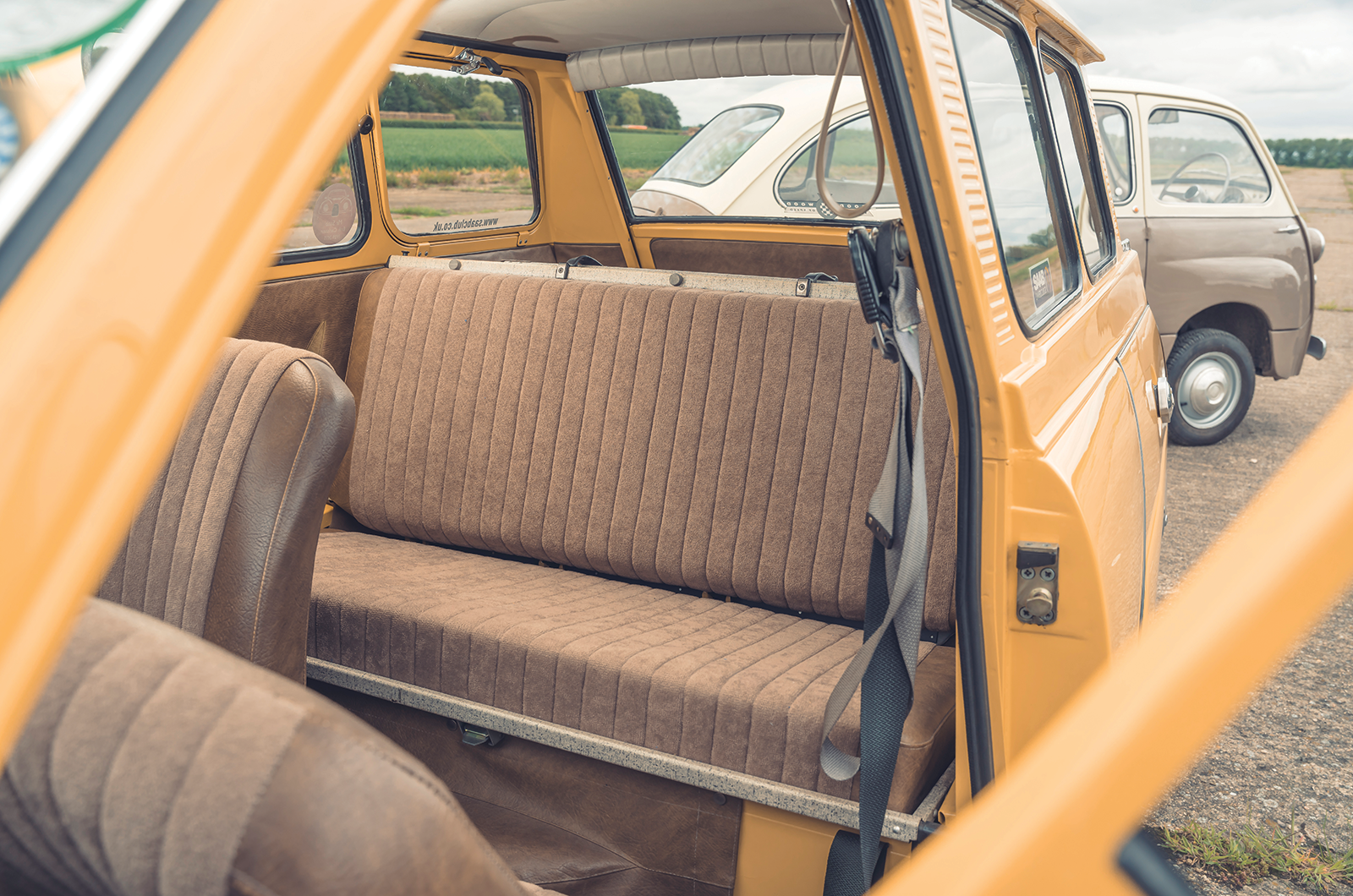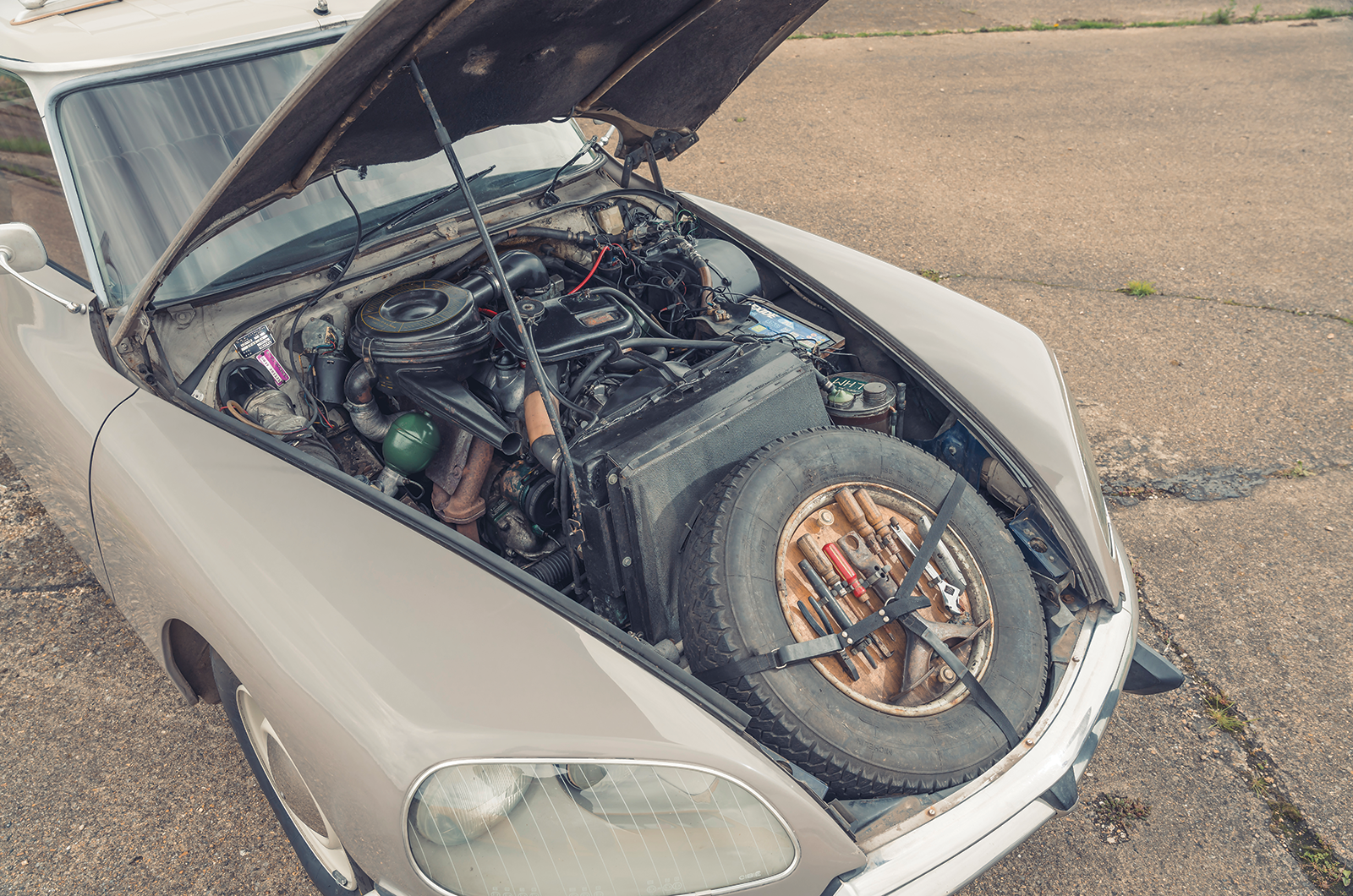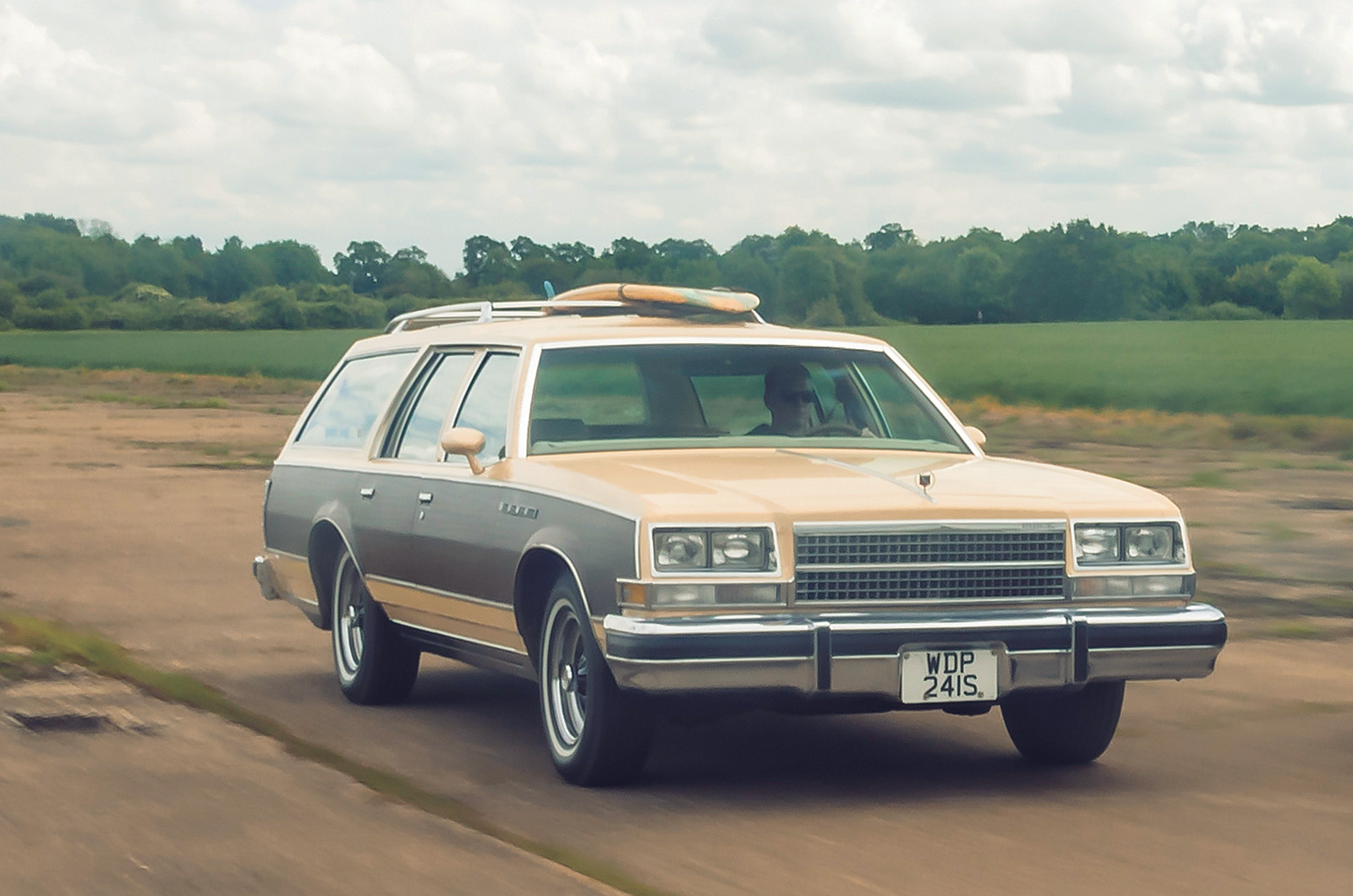Citroën based the specification on the cheaper ID, and customers could choose up to eight seats with two folding chairs in the load bay.
For 1967 a major facelift brought faired-in lights, and DS production ended eight years later.
The later dashboard also has an ominous-looking ‘Stop’ warning light straight from a B-movie spaceship.
Jamie Piggott of the DS Workshop owns ‘our’ Break, and a previous custodian fitted the 2.3-litre engine and five-speed manual gearbox from a 1972-’75 DS23.
Transverse seating in the Citroën DS20 Break’s rear
Jamie says: “I prefer the four-speed semi-automatic because I think it’s the car’s quintessence.
“It is esoteric and idiosyncratic, those elements that make the Citroën so wonderful. But I don’t mind the five-on-the-column, which is easy to use.”
Jamie finds the middle row of seats less comfortable than the saloon’s rear bench.
“It’s not as well-upholstered,” he says, “but it’s big enough to lug a wardrobe.
“All of the DS family was created to transport you from Paris to Nice in an afternoon.”
At more than 18ft long, the Buick Estate Wagon has a surplus of presence
The Break allows up to seven to enjoy the trip, with even occupants of the rearmost seats benefitting from the famous suspension.
Regardless of whether it’s a Break or saloon, it is always, to quote essayist Roland Barthes, the car that ‘has fallen from the sky’.
The final guest at our people-hauler party is even more remote from British motoring than the Fiat.
A fifth-generation 1978 Buick Estate Wagon powered by a 6.6-litre ‘403’ V8 belongs less on the minor roads of Peterborough and more on the highway to Lake Tahoe, taking an extended family to a weekend at the country club.
The Buick Estate Wagon boasts super-comfy seats
It is the sort of car favoured by a genially corrupt lawyer in an episode of Columbo.
The ‘woodie’ has a long tradition in American motoring history, but by 1953 Buick’s station wagons were of all-metal construction, apart from a vestigial panel on the tailgate.
Nearly three decades later, the Estate Wagon’s exterior décor still gave a sense of the great outdoors – or at least wearing a checked lumberjack shirt to the company’s summer picnic.
Buick introduced the Electra range in 1959 and launched the fifth-generation models for the ’77 model year.
The Buick’s Oldsmobile-designed V8 makes for effortless overtaking (left); there’s easy access to the rear-facing bench seats
The new line-up was 1000lb lighter than its predecessors, in response to the Fuel Crisis, while the Estate Wagon’s rear compartment was from the smaller Le Sabre.
Still, at more than 18ft long, Ross Mackenzie’s Buick feels substantial.
He bought it in January this year.
“I already owned a 1985 Limited sedan, but always wanted a station wagon,” he says. “When I saw this online, I had to have it.”
This 185bhp Buick boasts the range’s largest engine
Its bodywork is very well executed, including a multi-adjustable tailgate.
The standard car was around $5000, but when equipped with cruise control, electric windows, a remote-control bootlid lock and other essentials to modern living, the price neared $9000.
General Motors aimed Buicks at corporate executives who needed to make the right impression.
Above all, the Estate Wagon encourages the owner to move the column selector to Drive and head for the horizon, ferrying eight full-sized people in a mobile living room.
Multifarious, multipurpose and multinational, this diverse quintet of over-accommodating classic cars has something for everyone
The super-light steering typifies the effortless driving experience, matched by super-comfy seats.
The accelerator pedal is enormous and the transmission silky-smooth.
“Because this car has the largest engine offered, it makes overtaking easy,” adds Ross.
No wonder Car & Driver called the Buick ‘an exceptional vehicle’.
Selecting a victor is impossible, because each car so entertainingly fulfils its brief: conveying a large number of people in great style.
If I opt for the Morris, it is simply because the Isis belongs in a world now only seen in films on Talking Pictures TV – and because it really does feel as stately as a galleon.
Images: Max Edleston
Thanks to: Jon Bentley; Jon Burgess; DS Workshop; Flying Club Conington
Factfiles
Morris Isis Traveller
- Sold/number built 1955-’58/1850 (all S1 Travellers)
- Construction steel unitary body, with rear compartment in ash and aluminium
- Engine all-iron, ohv 2639cc straight-six, single SU carburettor
- Max power 86bhp @ 4250rpm
- Max torque 124lb ft @ 2000rpm
- Transmission four-speed manual with overdrive on third and fourth, RWD
- Suspension: front independent, by wishbones, torsion bars rear live axle, semi-elliptic leaf springs; telescopic dampers f/r
- Steering cam and lever
- Brakes drums
- Length 14ft 8¾in (4489mm)
- Width 5ft 5in (1651mm)
- Height 5ft 3in (1600mm)
- Wheelbase 8ft 11½in (2371mm)
- Weight 3220lb (1460kg)
- Mpg 21
- 0-60mph 19.8 secs
- Top speed 87mph
- Price new £1125 (with overdrive)
- Price now £5-10,000*
Fiat 600 Multipla
- Sold/number built 1956-’66/240,000
- Construction steel unitary
- Engine all-iron, ohv 767cc ‘four’, single Weber carburettor
- Max power 25bhp @ 4800rpm
- Max torque 34lb ft @ 3000rpm
- Transmission four-speed manual, RWD
- Suspension independent, at front by double wishbones rear semi-trailing arms; coil springs, telescopic dampers f/r
- Steering worm and roller
- Brakes drums
- Length 11ft 7in (3535mm)
- Width 4ft 9in (1448mm)
- Height 5ft 2in (1580mm)
- Wheelbase 6ft 6¾in (2000mm)
- Weight 737lb (1624kg)
- Mpg 38
- 0-60mph 43 secs
- Top speed 65mph
- Price new £653
- Price now £25-50,000*
Saab 95 V4
- Sold/number built 1966-’78/110,527 (all 95s)
- Construction steel unitary
- Engine all-iron, ohv 1498cc V4, single Autolite carburettor
- Max power 65bhp @ 4600rpm
- Max torque 85lb ft @ 2600rpm
- Transmission four-speed manual, FWD
- Suspension: front independent, by wishbones, telescopic dampers rear beam axle, trailing arms, lever-arm dampers; coil springs f/r
- Steering rack and pinion
- Brakes discs front, drums rear, with servo
- Length 14ft 1in (4300mm)
- Width 5ft 2½in (1580mm)
- Height 4ft 10½in (1475mm)
- Wheelbase 8ft 2in (2498mm)
- Weight 2160lb (980kg)
- Mpg 27
- 0-60mph 14.2 secs
- Top speed 90mph
- Price new £1233
- Price now £6-10,000*
Citroën DS20 Break
- Sold/number built 1958-’73/1,455,746 (all DS versions)
- Construction steel unitary
- Engine iron-block, alloy-head, ohv 1985cc ‘four’, single twin-choke Weber or Zenith carburettor
- Max power 103bhp @ 6000rpm
- Max torque 106lb ft @ 4000rpm
- Transmission five-speed manual or four-speed semi-automatic, FWD
- Suspension independent, by leading and trailing arms, oleo-pneumatic struts, anti-roll bar f/r
- Steering powered rack and pinion
- Brakes powered discs front, drums rear
- Length 16ft 6in (5030mm)
- Width 5ft 11in (1800mm)
- Height 5ft (1530mm)
- Wheelbase 10ft 3in (3124mm)
- Weight 3157lb (1432kg)
- Mpg 22.3
- 0-60mph 14.5 secs
- Top speed 105mph
- Price new £2098 (D Estate, 1973)
- Price now £15-30,000*
Buick Estate Wagon
- Sold/number built 1977-’79/25,964 (1978 Estate Wagons)
- Construction steel unitary
- Engine all-iron, ohv 6598cc V8, single Rochester four-barrel carburettor
- Max power 185bhp @ 3600rpm
- Max torque 320lb ft @ 2000rpm
- Transmission three-speed automatic, RWD
- Suspension: front independent, by wishbones, anti-roll bar rear live axle, four links; coil springs, telescopic dampers f/r
- Steering power-assisted recirculating ball
- Brakes discs front, drums rear, with servo
- Length 18ft ½in (5504mm)
- Width 6ft 8in (2030mm)
- Height 4ft 8 ½in (1435mm)
- Wheelbase 9ft 8in (2944mm)
- Weight 4134lb (1875kg)
- Mpg 17
- 0-60mph 11.2 secs
- Top speed 108mph
- Price new $5000
- Price now £10-15,000*
*Prices correct at date of original publication
Enjoy more of the world’s best classic car content every month when you subscribe to C&SC – get our latest deals here
READ MORE
The tale of the wonderful classic British woodie
Morris Oxford Traveller vs Borgward Isabella Combi: practically perfect?
Triumph 2500PI vs Citroën DS23 vs Lancia 2000IE: fuel for thought
Andrew Roberts
Andrew is a long-time contributor to Classic & Sports Car

